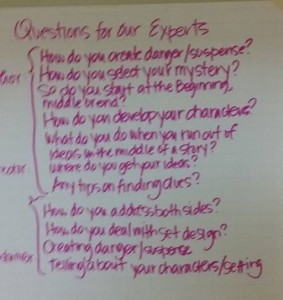How to Write a Mystery
A crappy Monday was made instantly better after fielding questions from a bunch of 10-year-olds on a conference call. The topic? How to write a mystery.
They’re writing an 8-minute play that will be performed in March. Here is a (somewhat blurry) screen shot of their questions, but you’ll get the gist. My favorite: “What do you do when you hit the middle of your story and you run out of ideas?”
I wrote up a quickie tutorial for them, and I thought I’d share it here. While I did write these tips with kids in mind, I think it can help all of us who love writing mysteries.
Start at the end. When you write a mystery, you should know how it’s going to end before you start developing it.
So if the story opens with a crime, like a museum robbery, by the end, the audience will know who the thief is. When developing the story in your mind, start at the end and work backwards. If you know Joe is the person responsible for the crime, map out how he did it, including how your main character is going to figure it out.
But when you open your book or play, get to the mystery ASAP. You want your audience to get excited for your story right away, so introduce the “mystery” part–the murder, the robbery, the weird things happening in the graveyard after midnight–right away.
Give your audience a main character to root for. You need someone solving the mystery, right? It could be an amateur sleuth (like a bunch of kids) or a professional, like a cop or private investigator.
Create tension and suspense by using the five senses. Think of things that might scare you or audience members: approaching footsteps when you’re walking alone, a piercing scream in the middle of the night, an old cemetery. You can infuse your story with sights, sounds, and so forth to make your audience feel what your main character is feeling.
For example, during a play, consider using the following devices on set:
- Lights to create a mood–somber, gloomy, weird, scary
- Sound effects that will startle your audience, such as thunderclaps
- Visual effects, such as fog machines or pictures hanging on a set where the eyes move
Make good use of “red herrings.” Red herrings are false clues–those clues that seem to be pointing in the right direction, but end up leading to a dead end. These false clues will keep your main character and audience guessing.
Read great mysteries for ideas! The best way to learn how to write mysteries is by reading them. When I was a kid, I loved reading The Hardy Boys and Alfred Hitchcock and the Three Detectives. Find mysteries that you love and ask yourself “why does this work?”
- How does the author keep me turning the page?
- How does the author build suspense?
- What sort of red herrings does the author throw in?
- How does the author end the story?
Here are some links to books to check out:
- http://www.readbrightly.com/9-mysteries-fourth-fifth-graders-recommend-friends/
- https://www.goodreads.com/list/show/493.Best_Mysteries_for_Young_Readers
Good luck!

